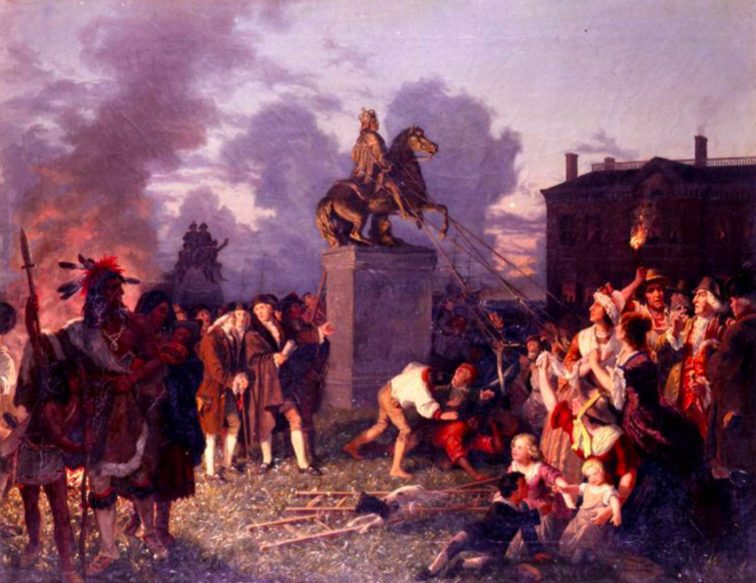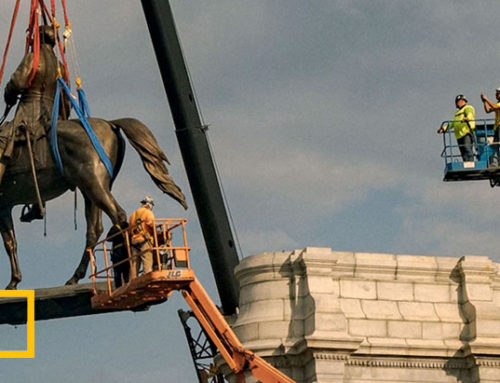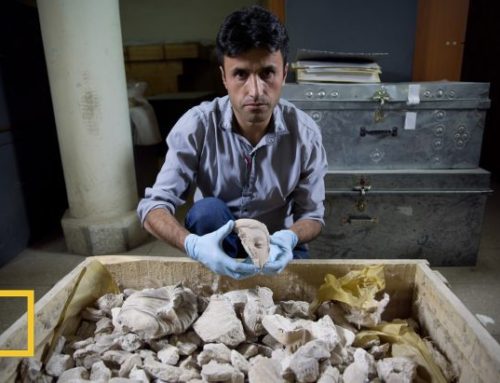Enthusiasm for the American Revolution led colonists to burn, disfigure, and deface any symbol of Britain and its hated king.

King George III plunges from his plinth in this romanticized version of the July 9, 1776 event in New York City, watched by Native Americans. The actual statue featured the monarch in Roman garb, and Africans Americans may have assisted in its spontaneous destruction. COURTESY OF NEW YORK HISTORICAL SOCIETY
Fireworks, bands, and cookouts are essential ingredients of any Fourth of July celebration. What’s usually not on the menu is toppling statues, ripping down signs, or burning portraits. But in the days following the new nation’s declaration of independence, Americans went on a frenzy of destruction that makes today’s attacks on Confederate and other symbols of white supremacy pale by comparison.
The most dramatic act took place in New York City on July 9, 1776. Early that evening, General George Washington and his troops, along with hundreds of citizens, crowded into what is now City Hall Park to hear a reading of the document that had just arrived from Philadelphia. The enthusiastic throng then headed for Broadway and the two-ton equestrian statue of King George III on Bowling Green.
This was the same route protestors took in 1765 when New Yorkers demonstrated against the Stamp Act taxing a host of goods. The following year, the colony’s assembly commissioned the statue in recognition of the king’s support in repealing the despised legislation. Modeled on the classical equestrian sculpture of Roman Emperor Marcus Aurelius, it arrived from London in 1770 and was erected with great pomp. When John Adams paid his first visit to New York in 1774, he wrote to his wife Abigail that the king’s statue was “very large, of solid lead, gilded with gold, standing on a pedestal of marble very high.”
Two years later, fervent New Yorkers, with the help of Washington’s soldiers, quickly pulled it from its plinth and broke it into pieces. Much of the lead was shipped to Connecticut and melted down to make 42,008 bullets.
[The statue] has been pulled down to make musket ball of, so that his troops will probably have melted Majesty fired at them.U.S. POSTMASTER
U.S. Postmaster Ebenezer Hazard wrote that the statue “has been pulled down to make musket ball of, so that his troops will probably have melted Majesty fired at them.”
A British officer who had the decapitated head rescued from a tavern before it reached the furnace noted that the nose was severed, the laurels were awry, and a musket ball was lodged “part of the way through his head.” He had it shipped back to London “to convince them at home of the infamous disposition of the ungrateful people of this distressed country.”
Washington wrote that while he didn’t doubt the zeal of those who mutilated the statue, he decried what had “so much the appearance of a riot, and want of order.” He told his soldiers to steer clear of such incidents in the future. (Washington also fought an epidemic during the American Revolution.)
And the destruction was just beginning. The British coat of arms in New York’s courthouse was destroyed, a stone pediment with the same image was smashed, and the king’s portrait in the council chamber was “thrown out, broken, torn to pieces, and burnt, of all which the people testified their approbation by repeated huzzas.” Churches were not exempt. A naval ensign wrote that clergy were given “the honor of taking down” the royal coat of arms. If they refused, “the people are allowed to proceed in the like manner.”
When the British regained control of New York in August, the royal governor reported that “every vestige of royalty, as far as has been in the power of the rebels, has been done away with.” Even the crowns decorating the wrought-iron fence surrounding the king’s likeness were ripped out.
Statues and royal portraits were relatively rare items in the colonies, however, so “revolutionaries eliminated scraps of paper, tokens, anything signaling royal authority,” says Brendan McConville, a Boston University historian. “Crowds attacked tavern signs with the king’s arms or crowns on them. Even coins bearing the king’s likeness were refused or devalued.”
After the declaration was first read from the State House in Boston on July 18, “the cry from the balcony was ‘God save our American States’ and then three cheers which rent the air,” wrote Abigail Adams, an eyewitness to the event. That evening, according to another patriot, “the king’s arms, and every sign with any resemblance of it. . .together with every sign that belonged to a Tory, was taken down, and made a general conflagration of in King Street.”
Four days later in Worcester, Massachusetts, the paramilitary group called the Sons of Freedom removed the king’s coat of arms from the courthouse and burned it in the street. The ringleaders then went to celebrate “the commencement of the happy era” in a pub called the King’s Arms. But first they took down the offending sign, “which was cheerfully complied with by the innkeeper.”
In Philadelphia, the king’s coat of arms in the courthouse was paraded through the streets and then cast into a bonfire to the delight of the assembled citizens. Portraits of the king and of members of the royal family in New Hampshire and Delaware were defaced. After the declaration was read in Savannah, Georgia, on August 10, the rebels held a mock funeral and buried an effigy of George III. (Here’s what archaeologists are learning from a colonial toilet.)
Destroying these symbols was “not wholly or principally an act of erasure,” argues University of Delaware art historian Wendy Bellion. The Americans were, in fact, following an old English tradition. A year after England’s King Charles I lost his actual head in 1649, Parliament ordered his statue at the Exchange in London “to be demolished, by having the head taken off, and the scepter [taken] out of his hand.” In 1689, Protestant soldiers in Newcastle removed a statue of Catholic King James II and dragged it through the streets before tossing it in the river.
The events of July 9, 1776, recently prompted a meme featuring an image of the British monarch and his horse falling to the ground. “After hearing a reading of the newly adopted Declaration of Independence, New Yorkers ‘Destroy History’ by toppling a statue of King George III,” the tongue-in-cheek caption read. “And that’s why no one knows who won the American Revolution.”
As 18th-century New Yorkers would learn, however, it proved relatively easy to tear down a symbol of oppression, but it took years of struggle to make that era’s entrenched authority reflect the will of the people. “They could execute the tyrant’s symbol in their towns and villages,” says McConville. “Ending the monarchy within each of them proved more difficult.” The ongoing effort to end racism—and live up to the aspirations of the Declaration of Independence—doubtless will prove just as challenging.




